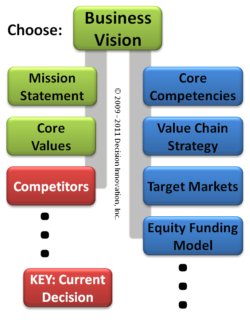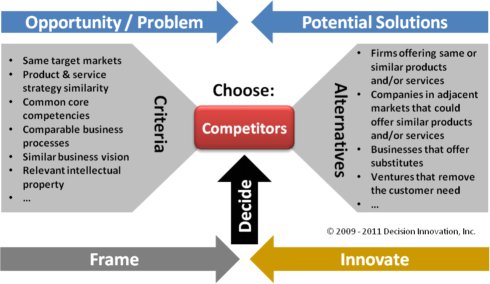Effective competitive business analysis starts with choosing your competitors
 Competitive business analysis is an important part of the strategic decision making for your company. Choosing an effective set of competitors can be critical to the ongoing viability and success of your firm. Competitors, and substitutes, along with disruptors from adjacent markets, are all looking to meet the needs of your target market and potentially take your customers. A successful competitive business analysis will find competitors (both obvious & hidden) that will lead to decisions and action that create near and long term competitive advantage.
Competitive business analysis is an important part of the strategic decision making for your company. Choosing an effective set of competitors can be critical to the ongoing viability and success of your firm. Competitors, and substitutes, along with disruptors from adjacent markets, are all looking to meet the needs of your target market and potentially take your customers. A successful competitive business analysis will find competitors (both obvious & hidden) that will lead to decisions and action that create near and long term competitive advantage.
Do we really choose competitors?
It is a very rare case that a business does not have competition. A successful venture is always looking to meet an unmet or poorly met need of a customer. Unless your business has created a solution that is difficult to duplicate (or substitute) for a previously undiscovered or unmet need, you will likely have competitors, perhaps many. Your solution may be very unique, but competition comes from the alternatives customers have for meeting their needs and desires.
Choosing competitors is about selecting a small but sufficient competitor group for use in a competitive business analysis. Given the effort involved to gather competitive intelligence and complete an analysis that leads to actionable recommendations, it is critical that you make this decision systematically.
Criteria for choosing competitors for a competitive business analysis
 The key is to find competitors that enable better strategic decisions that create competitive advantage. It is important to avoid excessive cost that would come with a competitor group of businesses that is too large.
The key is to find competitors that enable better strategic decisions that create competitive advantage. It is important to avoid excessive cost that would come with a competitor group of businesses that is too large.
The following criteria can be used to choose companies that would be used in your competitive business analysis.
- Same target markets - Competitors that participate in one or more of the current or envisioned target markets for the business
- Product & service strategy similarity - Businesses that have a similar product and/or service strategy or offer a similar portfolio of products and services
- Common core competencies - Companies whose management team, founders, key players or advisors have core competencies in common with your business. This can include technology, management, process, ...
- Comparable business processes - Firms that appear to have comparable underlying business processes
- Similar business vision - Ventures that have a similar vision for the future at a business unit level
- Relevant intellectual property - Competitors who have intellectual property that could be used to limit your market opportunities
- Capitalization strength - Corporations with strength in financial capitalization that could enter your target market
- Brand similarity - Companies who appear on the surface to have a similar brand identity
- Organization maturity- Organization's level of maturity to serve customers in planned target markets. This includes maturity in distribution, sales, channels, quality, customer relationships, ...
- Participates in relevant industry groups - Firms who are actively participating in relevant industry groups that serve your target market
Finding business competitors to consider
Choosing business competitors for your analysis will be unique to your situation, but there are four areas to consider when creating your initial list.
- Firms offering same or similar products and/or services - This list would include the competitors that come to mind quickly as currently providing solutions that meet the customer's need.
- Companies in adjacent markets that could offer similar products and/or services - Companies that have similar core competencies would be the starting point for this list. Companies looking to grow will look first at adjacent markets where they can leverage the current capabilities of the firm. If barriers to your market are low, there are two possibilities; create responses that prevent their entry into the market (such as lower your prices), or identify new ways to compete once they enter (such as providing additional service).
- Businesses that offer substitutes - People can often find clever ways to meet their needs that may use a combination of products, services, and their own effort. Substitute solutions can evolve into competitive threats, particularly if a new technology provides substitutes with a significant improvement for customers in your target market.
- Ventures that remove the customer need - This category of disruptive competition can be deadly for a company or, in some cases an industry. Looking here can be a significant enhancement to a competitive business analysis. Anybody still looking for film for their camera?

A competitive business analysis should influence your strategic decision making
From our decision making model, the choice of competitors is seen as a guiding decision for the strategic decisions of the business (as seen in the decision network example above). Competitor analysis can lead to more effective business decision making at all levels of the decision network.
An effective choice of competitors, along with a systematic competitive business analysis, will:
- prevent being blindsided by competitors,
- enable proactive responses to competitive forces,
- improve marketing strategies,
- reveal new opportunities to increase customer value, and
- provide early warning to larger industry shifts.
If your business is in a concentrated industry, a competitive business analysis becomes vital to achieving (and maintaining) competitive advantage. This can be particularly important in high tech industries.

Return from Competitive Business Analysis to Business Decision Making
